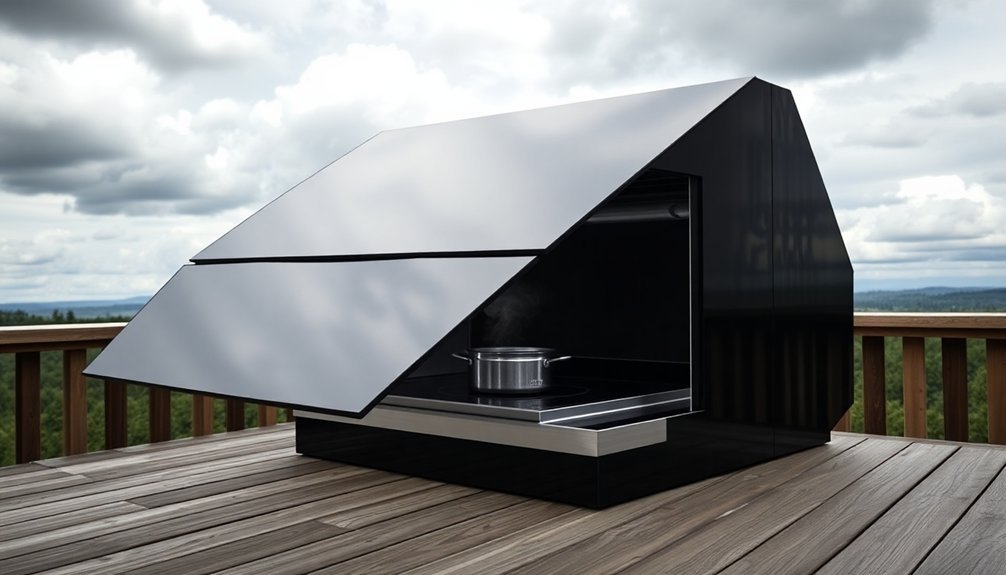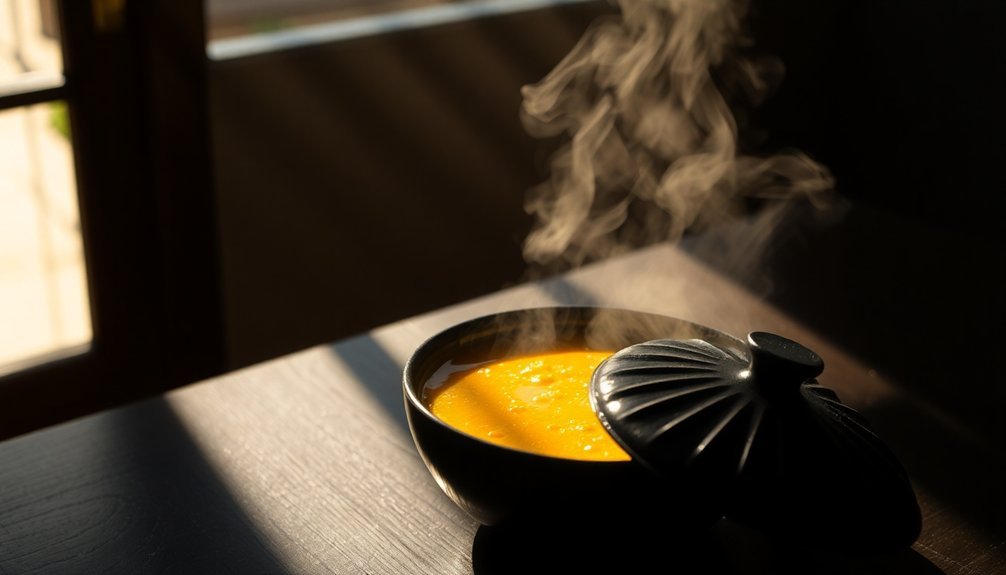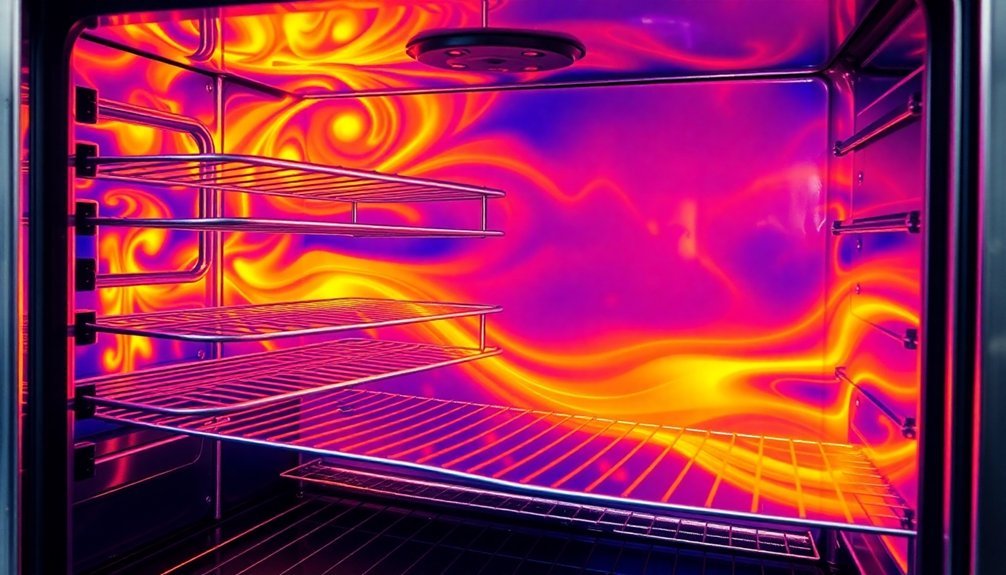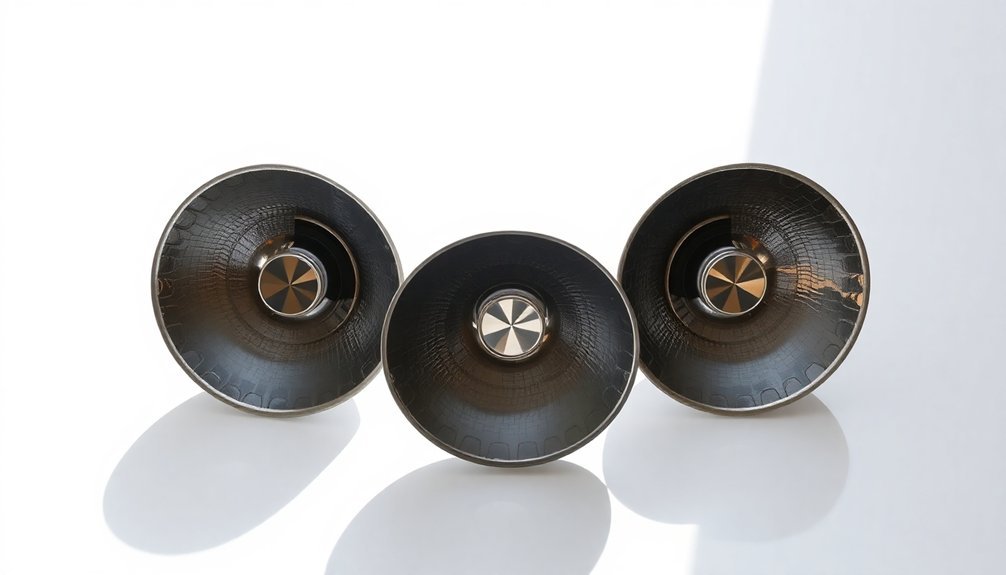Yes, your solar oven will still work when clouds roll in, though you'll need to adjust your cooking strategy. While temperatures drop to 200-250°F in cloudy conditions, you can offset this by extending cooking times by 25-50%. Plan to position your oven between 11 AM and 3 PM to maximize available sunlight, and use dark-colored cookware with tight-fitting lids to enhance heat retention. You'll want to cut ingredients into smaller pieces and focus on recipes suited for slower cooking methods, like soups and stews. Understanding a few key adjustments can help you master solar cooking in any weather.
Understanding Solar Oven Cloud Performance

While solar ovens perform best under direct sunlight, they can still function effectively in cloudy conditions.
You'll find that even on overcast days, substantial solar heating occurs during periods of high light intensity. Though clouds reduce peak temperatures, your oven will continue to heat food and materials.
You'll notice temperature fluctuations more on cloudy days, as intermittent sunlight penetrates through breaks in cloud cover. Using 3- to 4-day treatment periods helps ensure adequate heating even with variable cloud conditions.
Even with hazy skies from wildfire smoke, your solar oven can exceed necessary heating thresholds. Think of it like a slow cooker – it may take longer, but the food will still cook.
The key is understanding that clouds don't stop solar heating completely; they simply extend cooking times and create more variable conditions that you'll need to account for in your cooking plans.
Best Preheating Times for Success
Your preheating time needs to be longer in winter months and on cloudy days, often requiring up to two hours compared to the standard one-hour preheat during peak summer conditions.
You'll get the best results by starting your preheat early in the morning for lunch cooking or midday for dinner preparations, ensuring maximum sun exposure during peak hours. Regular monitoring throughout the day helps maintain optimal cooking temperatures as the sun's position changes.
When clouds are present, you can compensate for reduced solar energy by extending your preheat window and positioning your oven to capture any available direct sunlight periods.
Morning Vs Afternoon Timing
Understanding when to preheat your solar oven can make the difference between a successful meal and disappointment.
While you can begin preheating as early as 10:00 am, the most effective morning preheating starts around 11:00 am when the sun climbs higher. You'll notice significant temperature increases within 20 minutes on clear days.
Afternoon sessions, particularly between 1:00 pm and 3:00 pm, offer peak performance with temperatures often exceeding 300°F. You'll need to adjust your oven every 30 minutes to track the sun's movement. The oven can reach temperatures of 400°F on clear days when properly aligned.
- Morning preheating (11:00 am – 12:00 pm) works best for slow-cooking items like stews
- Afternoon preheating (1:00 pm – 3:00 pm) is ideal for baked goods requiring high heat
- Post-cooking warming keeps your meal hot until serving time
Seasonal Preheating Adjustments
Seasonal changes dramatically affect how you'll need to preheat your solar oven throughout the year.
In winter, you'll face longer preheating times due to lower sun angles and colder temperatures, often requiring up to an hour before reaching cooking temperature. You'll need to realign your oven more frequently to maintain proper sun exposure.
Summer offers more efficient preheating, with times as short as 20-30 minutes on clear days. You can achieve temperatures up to 400°F, but you'll need to monitor carefully to prevent overheating.
For best results year-round, use dark-colored ovenware and proper insulation to maximize heat retention. Check your oven's temperature regularly with a thermometer and adjust its position every 30 minutes to follow the sun's path, ensuring consistent cooking temperatures regardless of season.
Weather Impact on Duration
When clouds roll in, your solar oven's preheating requirements change dramatically. You'll need to allow 2-4 times longer for cooking compared to sunny days, as your oven relies on diffused light rather than direct sunlight.
Even partial cloud cover will considerably impact your cooking efficiency, so proper preheating becomes critical for success.
- Preheat your oven for at least an hour before cooking to maintain consistent temperatures
- Adjust your oven's orientation frequently to maximize exposure to available sunlight
- Use reflective materials to concentrate whatever sunlight is available
Remember to keep the cover zipped during preheating to retain heat effectively.
While cloudy conditions make cooking more challenging, you can still achieve good results by planning ahead and being patient with the extended cooking times.
Regular monitoring and adjustments will help maintain ideal cooking conditions throughout the process.
Temperature Adjustments During Cloud Cover

When clouds roll in, you'll need to extend your cooking time by 25-50% to compensate for reduced solar intensity and fluctuating temperatures.
You can maintain heat by keeping the oven's lid closed, ensuring proper insulation, and minimizing the time spent checking on your food.
To maximize heat retention during cloudy periods, it's essential to position your solar oven for ideal sunlight exposure and use reflective surfaces to capture any available rays.
Longer Cooking Times Needed
Since cloud cover greatly impacts solar oven performance, you'll need to adjust your cooking times to accommodate lower temperatures. When clouds partially block the sun, expect temperatures to drop to 200-250°F, requiring 1.5 to 3 times longer cooking periods than normal recipes suggest.
- Quick items like melted cheese, baked eggs, and pizza crackers still cook in under an hour.
- Medium-difficulty foods such as cookies, vegetables, and quick breads need 1 to 1.5 hours.
- Large items including whole chickens, pot roasts, and dried beans can take 3 to 7 hours.
You'll want to monitor your food's progress with a meat thermometer rather than relying on standard cooking times.
Remember to rotate your oven every 30 minutes to maintain ideal temperatures despite cloud interference.
Heat Retention Strategies
Despite cloudy conditions, you can maintain ideal cooking temperatures in your solar oven through strategic heat retention techniques.
Use dark-colored pots and dishes with lids to trap heat effectively, and guarantee your oven has proper insulation with materials like rockwool or polystyrene sheets on all sides except the glazed surface.
You'll want to keep your oven covered with a high R-value insulated top during cloudy periods to prevent heat loss.
Double or multi-glazed glass panels, combined with precise air spacing, will greatly reduce heat escape through convection.
Add aluminum foil as a radiant reflector, and incorporate layers of spun fiberglass or crumpled newspaper for extra insulation.
Strategic Positioning for Maximum Heat
To maximize your solar oven's heat absorption, proper positioning plays an essential role throughout the day. Position your cooker between 11:00 AM and 3:00 PM when sun intensity peaks, and angle it to match your location's latitude.
You'll want to reposition every 20-30 minutes to track the sun's movement for consistent heating.
- Perform a shadow test to verify proper alignment – the shadow should fall directly behind your cooker
- Orient the shorter front panel eastward for noontime meals or westward for evening cooking
- Create wind protection using stones or bricks for stability, and maintain an air gap under your pot with a wire rack
During winter or shorter sun seasons, start cooking earlier around 10:00 AM to make the most of available sunlight.
Essential Equipment and Setup Tips

Building an effective solar oven requires specific materials and careful attention to setup details. You'll need durable outer materials like cardboard or wood, plus proper insulation using newspaper or sawdust. Line your oven's interior with aluminum foil to reflect heat and add black construction paper at the bottom for heat absorption.
| Component | Purpose | Key Tips |
|---|---|---|
| Window | Sunlight Entry | Use double-layer plastic wrap |
| Insulation | Heat Retention | Pack tightly between walls |
| Reflectors | Light Direction | Adjust angles for maximum sun |
| Base Layer | Heat Absorption | Apply black material evenly |
| Ventilation | Temperature Control | Create adjustable flaps |
For peak performance, create a tight seal with your transparent cover and position reflector flaps to direct maximum sunlight into the cooking chamber. You'll want to preheat your oven for an hour before cooking to reach ideal temperatures.
Recipes Perfect for Cloudy Days
Since cloudy conditions affect solar cooking times, choosing the right recipes can make all the difference in your success.
You'll want to focus on meals that work well with slower cooking methods and don't require intense heat. Simple dishes like warming soups, melting cheese, and baking cookies are ideal choices for overcast days.
- Cut ingredients into smaller pieces to speed up cooking time
- Use oven bags to retain moisture and heat while preventing condensation
- Select ingredients that naturally cook slowly, like lentils and potatoes
When preparing meals on cloudy days, you'll find success with basic recipes like hot dogs, pizza with melted cheese, or warming pre-cooked items.
Don't forget that eggs work wonderfully in breads and casseroles, while instant soups and oatmeal are reliable options that won't leave you disappointed.
Extending Your Solar Cooking Time

Several key strategies can considerably extend your solar cooking time during cloudy conditions.
Start by maximizing your oven's insulation with multiple layers of newspaper or foam board, and guarantee you're using a well-sealed inner box with a plastic window to trap heat effectively.
You'll get the best results using black cooking pots with tight-fitting lids, as they absorb and retain heat more efficiently.
Don't forget to preheat your solar oven for up to an hour before cooking, and keep the lid closed as much as possible to maintain temperature.
When clouds appear, adjust your cooking time – expect it to take about twice as long as conventional methods.
Position your oven away from wind and use reflectors to capture more sunlight.
Remember to rotate your food every 10-15 minutes for even cooking.
Frequently Asked Questions
Can Solar Ovens Be Used to Dehydrate Fruits and Vegetables?
Yes, you can use solar ovens to dehydrate fruits and vegetables efficiently. You'll need proper racks, temperature control between 110-150°F, and direct sunlight. It's an eco-friendly method, though drying takes 2-3 days.
How Long Does a Homemade Solar Oven Typically Last Before Needing Repairs?
Your homemade solar oven can last 10-15 years with proper care. You'll need to replace plastic windows or reflective materials every few years, and you should regularly inspect and maintain the insulation and structural components.
What Safety Precautions Should Be Taken When Using Solar Ovens?
You'll need to keep the oven away from flammable materials, use heat-proof gloves, monitor food temperatures with a thermometer, and prevent children from accessing it. Always maintain proper food safety practices while cooking.
Does Altitude Affect Solar Oven Cooking Efficiency and Temperature?
Yes, altitude affects your solar oven's performance. You'll get more intense solar radiation at higher elevations, but you'll need better insulation to combat lower temperatures and thinner air that can reduce heat retention.
Can Solar Ovens Be Used to Sterilize Medical Equipment Effectively?
Yes, you can effectively sterilize medical equipment using solar ovens that reach 160°C for 60 minutes. With proper design and insulation, they'll meet CDC sterilization guidelines, even when accounting for instrument heat absorption.
In Summary
You'll still achieve great results with your solar oven on cloudy days by following these key strategies. Remember to preheat early, use dark cookware for better heat absorption, and position your oven for ideal sunlight exposure. Don't let a few clouds discourage you – with proper temperature monitoring and recipe adjustments, you're ready to harness solar power for cooking in various weather conditions.





Leave a Reply